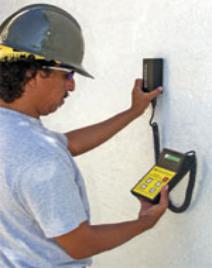Description
Covermeter is the general term for a rebar detector
used to determine the location and size of reinforcing steel in a concrete or
masonry wall. The basic principle of most rebar detectors is the interaction
between the reinforcing bar and a low frequency magnetic field. If used
properly, many types of rebar detectors can also identify the amount of cover
for the bar and/or the size of the bar. Rebar detection is useful for verifying
the construction of the wall, if drawings are available, and in preparing
as-built data if no previous construction information is available.
Equipment
Several types and brands of rebar detectors are
commercially available. The two general classes are those based on the
principle of magnetic reluctance and those based on the principle of eddy. The
various models can have a variety of features including analog or digital
readout, audible signal, onehanded operation, and readings for reinforcing bars
and prestressing tendons. Some models can store the data on floppy disks to be
imported into computer programs for plotting results.
Conducting Test
The unit is held away from metallic objects and
calibrated to zero reading. After calibration, the unit is placed against the
surface of the wall. The orientation of the probe should be in the direction of
the rebar that is being detected. The probe is slid slowly along the wall,
perpendicular to the orientation of the probe, until an audible or visual spike
in the readout is encountered.
The probe is passed back and forth over the region
of the spike to find the location of the maximum reading, which should
correspond to the location of the rebar. This location is then marked on the
wall. The procedure is repeated for the perpendicular direction of reinforcing.
If size of the bar is known, the covermeter readout
can be used to determine the depth of the reinforcing bar. If the depth of the
bar is known, the readout can be used to determine the size of the bar. If
neither quantity is known, most rebar detectors can be used to determine both
the size and the depth using a spacer technique.
The process involves recording the peak reading at
a bar and then introducing a spacer of known thickness between the probe and
the surface of the wall. A second reading is then taken. The two readings are
compared to estimate the bar size and depth. Intrusive testing can be used to
help interpret the data from the detector readings. Selective removal of
portions of the wall can be performed to expose the reinforcing bars. The rebar
detector can be used adjacent to the area of removal to verify the accuracy of
the readings.
Personnel Qualifications
The personnel operating the equipment should be
trained and experienced with the use of the particular model of covermeter
being used and should understand the limitations of the unit.
Reporting Requirements
The personnel conducting the tests should provide a
sketch of the wall indicating the location of the testing and the findings. The
sketch should include the following information:
•
Mark the locations of the test on either a floor plan or wall
elevation.
•
Report the results of the test, including bar size and spacing and
whether the size was verified.
•
List the type of rebar detector used.
•
Report the date of the test.
•
List the responsible engineer overseeing the test and the name of the
company conducting the test.
Limitations
Pulse-velocity measurements require access to both
sides of the wall. The wall surfaces need to be relatively smooth. Rough areas
can be ground smooth to improve the acoustic coupling. Couplant must be used to
fill the air space between the transducer and the surface of the wall. If air
voids exist between the transducer and the surface, the travel time of the
pulse will increase, causing incorrect readings.
Some couplant materials can stain the wall surface.
Non-staining gels are available, but should be checked in an inconspicuous area
to verify that it will not disturb the appearance.
Embedded reinforcing bars, oriented in the
direction of travel of the pulse, can affect the results, since the ultrasonic
pulses travel through steel at a faster rate than will significantly affect the
results. The moisture content of the concrete also has a slight effect (up to
about 2 percent) on the pulse velocity.
Pulse-velocity measurements can detect the presence
of voids or discontinuities within a wall; however, these measurements cannot
determine the depth of the voids.





0 Comments